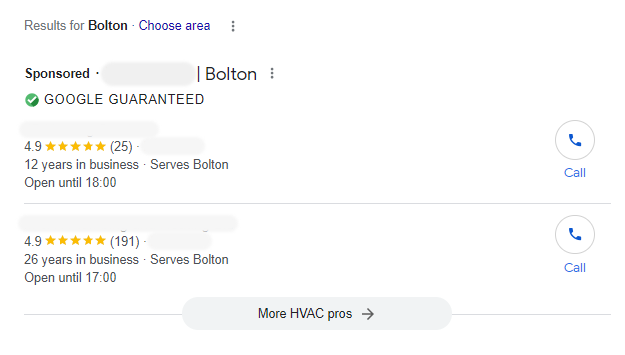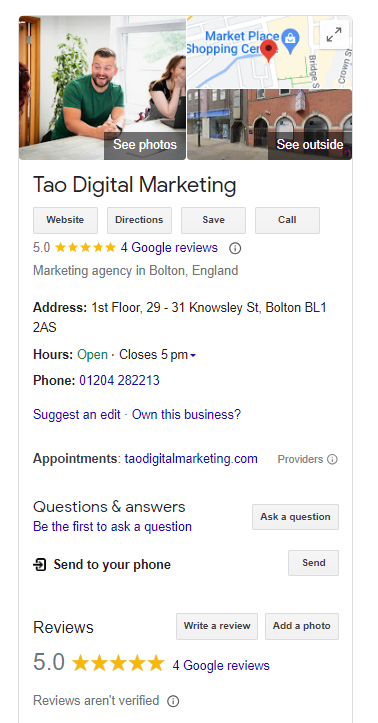SEO vs. CRO: Which Should You Focus On?
Search Engine Optimisation (SEO) vs. Conversion Rate Optimisation (CRO) has recently been a subject of heated debate. Many businesses ask, “Which one should I invest in?”
Truthfully, there’s no comparison between the two. They’re on the same side of the equation, meaning you cannot have one without the other. Understanding both SEO and CRO is crucial for success in any industry.
So, with that in mind, let’s jump into everything you must know about SEO and CRO.
Search Engine Optimisation (SEO) 101
SEO is crucial if you want to be found in Google SERPs (Search Engine Results Pages). Think about how often you start your search for the right brand based on Google. Yet only 71% of businesses have a website in 2023, showing how much value the UK’s business community misses out on.
But having a website isn’t enough. Businesses need an SEO-optimised website. You appear in Google SERPs by creating a website and optimising your pages by following Google’s algorithms. Techniques include targeting relevant keywords and acquiring backlinks. Rank higher in SERPs, and you’ll attract more traffic.
SEO is simple to understand as a concept, but executing an impactful SEO strategy is easier said than done because you’re competing against millions of other websites.
Conversion Rate Optimisation (CRO) 101
On the other hand, CRO is the process of optimising your website for conversions. In other words, once someone visits your website, your site is set up to encourage action from your visitors.
Different elements you might focus on include landing pages, menu bars and content. Excel in CRO, and your sales-to-visitors ratio will increase.
What does an excellent CRO look like? According to Forbes, an eCommerce website’s average conversion rate ranges from 1.84% to 3.71%. It may not sound significant, but this can have a massive impact on your bottom line over thousands of visitors.
Key differences between SEO and CRO for business growth
SEO and CRO are essential for driving traffic to your website and landing new customers. Although they work in tandem, they have several key differences that mark them out as distinct, including:
- SEO focuses on increasing traffic quantity and quality.
- CRO improves the percentage of visitors who take a desired action, such as contacting your sales team, subscribing to your newsletter, or making a purchase.
In short, SEO is focused on encouraging people to visit your website, whereas CRO’s purpose is engagement.
How SEO and CRO Work Together
SEO and CRO are not the same, but they are interdependent. For example, your SEO may have ranked you on the first page of Google SERPs, but if people land on a low-quality website, they’ll click away.
Likewise, you can have a website geared for conversions, but if your SEO isn’t on-point, nobody will see your brand’s site in the first place. Moreover, Google’s algorithms increasingly account for the on-site user experience for SEO purposes.
Over time, SEO and CRO have become more closely entwined, meaning you can only succeed in one if you succeed in the other.
Why are both SEO and CRO important for business growth?
Establishing that both impact business growth is one thing, but why do they combine so well to drive results?
Sites that fail to rank will not result in conversions or business revenue. In contrast, if your plan solely focuses on ranking, you will unlikely acquire the desired results. The key to achieving business growth is to ensure that every element of your site answers the searcher’s query.
Let’s focus on content as a means to drive business growth. Here are three points to consider to generate business growth:
- Create Content to Match Intent—Which content best answers the searcher’s query? Google asks this question every time, but it also includes the caveat that the page must offer the best possible user experience.
- Optimise Content for Conversions—Strategically telling people what you want them to do turns informative content into converting content. Again, this increases click-through rates and creates action, which Google recognises for SEO purposes.
In other words, SEO and CRO optimisations inform each other. Succeeding in one area will enable you to succeed in another area. Moreover, if we examine SEO principles, time-on-page and click-through rates are as important in SEO as in CRO.
How to find the right balance between SEO and CRO
Achieving optimal results means striking the right balance between SEO and CRO. But what does this look like in the field?
- Align Your Goals —Your SEO and CRO goals should complement each other and be aligned with your overall marketing objectives. In other words, they shouldn’t compete; they should collaborate.
- Keyword Optimisation for CRO – Bring high-converting keywords into your landing pages and other content to deliver synergy between SEO and CRO.
- Operate on the Data – Data analytics should be at the heart of your online marketing decisions. Don’t separate your SEO and CRO data or examine it in isolation. Combine both to make informed decisions, whether improving the user experience or optimising your landing pages.
- Make User Experience Your Number One – The user experience is everything. Focus on what makes your business more appealing to users, such as fast loading speeds and persuasive content writing.
- Test and Repeat —Make A/B testing part of your typical marketing schedule to determine what works and what doesn’t. Likewise, constant testing ensures your website doesn’t get stale and tumble down the rankings.
- Personalisation —Personalisation is a powerful tool for targeting different customer segments. Tailoring your messaging increases the odds of making an impact on each segment. Combining your personalisation strategies with SEO can also inform landing page optimisation, which will only boost your rankings.
As you can see, countless options exist for combining SEO and CRO. It’s less about finding a balance and more about understanding that you cannot have one without the other.
Tracking the impact of SEO and CRO
Any marketing campaign requires monitoring to understand whether it’s achieved success. Some examples of both SEO and CRO impacts include:
- Organic traffic
- Keyword rankings
- SERP visibility
- Click-through rate
- SERP visibility
- Bounce rate
- Conversions
- Website authority
Which metrics you focus on must be defined before you launch your campaign. Every marketing effort is different, meaning no two businesses will draw the same line between success and failure.
Achieve SEO and CRO Synergy With Tao Digital Marketing
Managing SEO and CRO can be complicated. Even if you understand how both work, running these campaigns takes valuable time and resources away from your business.
Kickstart your next online marketing campaign by working with a team of experts who understand what works for you. We incorporate your goals, expectations and niche to provide the best possible solution. To learn more, contact Tao Digital today.





